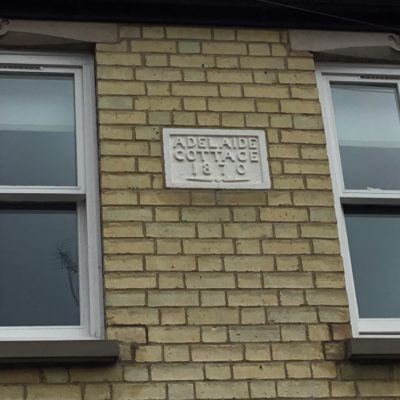Search by topic
- archaeology
- Building of Local Interest
- chapel
- charity
- church
- crime
- dressmaker
- fire
- Great Eastern Railway
- Listed building
- Mapping Relief
- medieval
- oral history
- poverty
- Public House
- Religious House
- Roman
- scholar
- school
- Then and Now
- tudor
- women
- work
- world war one
- world war two
Search by text
75 Ainsworth Street
75 Ainsworth Street
Number 75 is one of a pair of terraced houses on the west side of Ainsworth Street.
1881 census
Walter Hardingham, head, 32, railway porter on GER, b. Salhouse, Norfolk
Elizabeth Hardingham, wife, 36, b. Mildenhall, Suffolk
Walter E Hardingham, son, 12, scholar, b. Cambridge
Albert G Hardingham, son, 9, scholar, b. Cambridge
Earnest R Hardingham, son, 7, scholar, b. Cambridge
Lilian E Hardingham, daughter, 3, scholar, b. Cambridge
Walter J Hardingham, nephew, 14, scholar, b. London, Middlesex
The relationship of 12-year-old Walter [Ellis] Hardingham to the head of the household is not easily legible, but must be ‘nephew’ crossed out and replaced by ‘son’; the same applies to his brothers Albert and Earnest. Ellis Hardingham, aged 3, appears in the 1871 census for 24 Norwich Street, with his parents Walter and Elizabeth.
14-year-old Walter J Hardingham really was a nephew. He was the son of Walter senior’s brother George, a brewer’s labourer, who lived with his wife and younger children in St Martin’s in the Fields, London.
1891 census
William H Rayner, head, 38, corn [purser], b. Trumpington, Cambridgeshire
Lucy Rayner, wife, 40, b. Chrishall, Essex
William Thomas Rayner, son, 14, errand boy, b. Cambridge
Ernest E Rayner, son, 11, scholar, b. Cambridge
John Rayner, son, 10, scholar
George Henry Rayner, son, 7, scholar, b. Cambridge
Elizabeth M Rayner, daughter, 5, scholar, b. Cambridge
Alfred Rayner, son, 2, b. Cambridge
Edith L Rayner, daughter, 1 month, b. Cambridge
Lawrence Rowson, boarder, 17, grocer’s apprentice, b. Noswick, Norfolk
In the census of 1891 this terraced house has an astonishing number of inhabitants: nine members of the Rayner family plus a lodger! It was probably useful to have a small stipend coming in from the boarder to help pay to clothe and feed so many children.
William Rayner’s job is described as ‘corn’ with a note afterwards in another hand which possibly says ‘purser’ (rather than ‘porter’, as others have transcribed), so perhaps a seller of corn at the Corn Exchange on Wheeler Street in Cambridge.
1901 census
George Sansom, head, 32, butcher, own account, b. Cambridge
Anne Sansom, wife, 30, b. Sutton, Cambridgeshire
Hilda Sansom, daughter, 4, b. Cambridge
Thomas Sansom, son, 3, b. Cambridge
Florence Sansom, daughter, 6 months, b. Cambridge
Hannah Gotobed, mother, 56, monthly sick nurse, b. Sutton, Cambridgeshire
George was one half of the butcher’s company Swann and Sansom. They ran their business from 100 Sturton Street.
1911 census
Robert Andrew Everett, head, widower, 56, builder’s labourer, b. Duxford
Ruth Elizabeth Everett, daughter, 33, domestic [duties], at home, b. Duxford
Albert William Silk, boarder, 29, fitter’s mate, Great Eastern Railway, b. Cambridge
Fred Stubbs, boarder, single, 20, slater’s labourer, b. Cambridge
Robert Everett had had eight children, of which one had died.
1921 census
Percy Baker, head, 33, joint maker’s assistant, Great Eastern Railway, b. Cambridge
Florence Baker, wife, 24, home duties, b. Cambridge
The electoral registers show that Percy Baker lived here between 1919 and 1922. He was born in 1888, the year his parents moved from 23 Ainsworth Street to 2 Stone Terrace on Stone Street. He married Florence Flack in 1918 and the newlyweds moved to 69 Ainsworth Street in 1922.
Source: 1881–1921 Census, Cambridgeshire, England, Electoral Registers, Burgess Rolls and Poll Books, 1722-1966,
Contribute
Do you have any information about the people or places in this article? If so, then please let us know using the Contact page or by emailing capturingcambridge@
License
This work is licensed under CC BY-NC-SA 4.0







